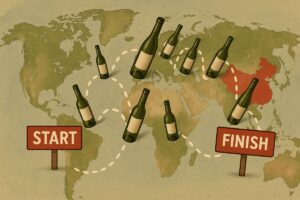
Two years of the pandemic have relaunched the direct sales and e-shops of Italian wineries, but in front of the direct relationship with customers, starting with wine tourism, there is still a lot of work to be done to fully exploit the potential of the Italian wine companies, as told by the report on wine tourism and direct to consumer sales provided by Divinea, the main Italian wine tourism portal, which took a photograph of how Italian wineries move in direct sales to consumers and in wine tourism activities, also compared to other international companies.
Although the activities in the cellar are increasingly diversifying, until now the service is still mainly based on the classic tasting of 3 and 5 wines and including the tour of the cellar which is present in almost all companies and corresponds to 71% of the overall wine tourism offer. The data shows that 4.6% of wineries do not have a structure designed to welcome visitors, while 68.2% carry out tastings, but do not have a dedicated resource. Just under 1 in 4 wineries have a person focused on hospitality, while only 3.1% have an organized team for wine tourism.
In comparison with the other major wine countries, thus, with a similar territory, New Zealand, which uses better its potential, would position 18 times the number of wine tours and experiences on the Italian market. France, on the other hand, with about a third of the number of annual visitors less than Italy, generates an internal wine tourism market that is almost double that of our country, and Napa Valley, California, which has annual visitors almost 4 times less than Italy, generates a return of 2 billion euros. This means that for the same number of visitors, Napa Valley could potentially collect 2.8 times the value of the Italian wine tourism market.
The arrival of the sanitary emergency has forced us to rethink the traditional sales channels of companies and to reassess investments in the direct-to-consumer and online channels, which historically had always had minimal market penetration. The data released by Mediobanca, in 2020 demonstrates that investments by major wine producers fall by 14.3% and their advertising spending reduced by 13.4%, digital investments increased by 55.8%, to which is added the growing number of e-commerce and Wine Clubs born in the last two years, and the increasing propensity of consumers to buy online: if before the lockdown 71% of Italians had never made an online purchase from a winery, today the share has dropped by seven points (64%).
The growth in direct sales, accelerated by the pandemic crisis, therefore made it possible in 2020 to exceed the psychological threshold of 10% of total turnover. However, Italy is still very far from the American model, where direct-to-consumer sales represent 2/3 of the total (66%) or more than 6 times the Italian market share. From this point of view, e-commerce, Wine Club, and other promotion channels (such as WhatsApp or newsletter) are useful tools to collect useful data for optimizing sales, especially because now the data confirm that most wineries receive fewer than 100 orders per year through e-commerce, and 42.5% of wineries deliver wine only in Italy.
More and more wineries are approaching the Wine Club: 17.3% of wineries have a Club while 75% of those who have not organized it yet, declare that they will make it or are considering doing it. The Italian Wine Clubs have many members but produce relatively low volumes, and the Italian wineries mainly offer access reserved for registered users and the eShop with special vintages and formats, while only one in five offers a subscription with the periodic shipment. As for other communication channels, 85% of wineries invest less than 200 euros per month to promote direct sales, and almost half of these do not allocate any budget. While communications with instant messaging - such as WhatsApp - are still little used, although they produce much higher conversions than emails, while telesales is not considered at all by 94% of companies.
And this is where another important limitation of Italian companies emerges, entirely technological: although the cellar is the best place to collect the data of its customers, only 22.4% of the wineries use a professional CRM (Customer Relationship Management software, ed. ) and only 26.7% manage to trace a customer history respectively to their purchases, despite the fact that in 2020, thanks to the pandemic, digital investments increased by 55.8%. Numbers that highlight large grown margins of Italian wineries through a new data and digital approach, which would allow them to increase their business, enhancing the experiences in the cellar and direct-to-consumer sales.
Copyright © 2000/2025
Contatti: info@winenews.it
Seguici anche su Twitter: @WineNewsIt
Seguici anche su Facebook: @winenewsit
Questo articolo è tratto dall'archivio di WineNews - Tutti i diritti riservati - Copyright © 2000/2025